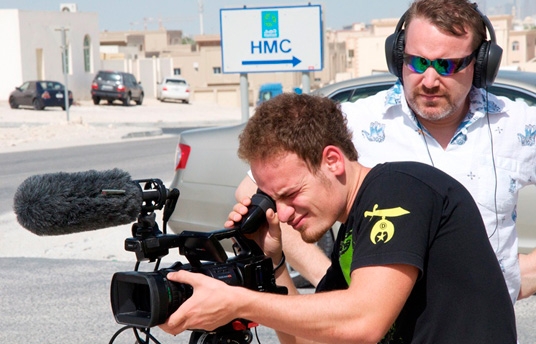DIY Documentary Part I – Development
Aug 29, 2011

Written by Jad Salfiti, Video Journalist, New Media
There are four key stages in any successful production process:
- Development
- Pre-production
- Production
- Post-production
In our first blog post, we’ll uncover the bare bones of development.
However, you need a story!
Development involves intensive research to find a story, and to analyse the ways in which your story idea can be turned into a film. Not every story – not even every good story – can, or should, be told through film.
Mentor Yasir Khan tells us about subjects to avoid in the development stage.
المدرّب ياسر خان يخبرنا عن المواضيع التي يجب تجنبها في مرحلة التطوير
For your plan to work as a film, you must have secure access to capture images that will allow you to tell the story. You must also convince the people involved to share their stories, their images, and their ideas, with you.
But first, you need to isolate your main idea. You need to break your story down into a concentrated version of the ideas you are turning into a film.
Yasir talks about the conventions of storytelling in film.
ياسر يتحدث عن المتعارف عليه في رواية القصص عبر الأفلام
Start with a one sentence version and include at least the key event, or turning point, in the story you want to tell. Every good documentary can be broken down into a simple formula: someone, or something, is going from ‘A’ to ‘B’, and must overcome an obstacle to get there. If you can isolate the simple, key journey of your story, you will be making great progress in the development phase of turning an idea into a film.
For example, here is a one-sentence plot premise for the award-winning documentary ‘Budrus’:
Ayed Morrar’s village, Budrus, is threatened by destruction by Israel’s separation barrier. His community is separated into factions and he must save his village before Israeli bulldozers roll in and build the wall on Budrus’ land […]
Here we can break this down into: Ayed is trying to save the Budrus village from destruction [getting from ‘A’ to ‘B’] but can’t because Israeli bulldozers are rolling into his village every day to build a “separation wall” [the obstacle].
In an outline of your idea, it’s crucial to identify the WHO, WHAT and HOW …the very basic elements of your story.
In ‘Budrus’ the WHO is Ayed Morrar. Saving the Budrus village from impending destruction by Israeli bulldozers is the WHAT. The documentary will revolve around HOW he does this.
The next stage in the development process involves expanding this one core idea into a more developed storyline. This slightly expanded version of your story is often called “a treatment”.
An easy way to grow your one sentence plot summary into a treatment is to use the following template:
- This story is a (poetic, expository, observational, participatory, performative documentary, etc);
- …about…(your protagonist, perhaps with an adjective or two);
- …who wants/needs/sets out to… (the protagonist’s problem or objective);
The story can be broken down as follows:
- First major obstacle of the story (i.e. what the protagonist does in pursuit of her/his objective).
- First major plot point of the story (i.e. what the protagonist does in pursuit of her/his objective).
- Second major plot point of the story.
- Third major plot point of the story
(Note: three plot points should be enough!) - The climax.
- The resolution (what the protagonist gained, lost or learnt).
This ‘treatment’ continues to be fleshed out until it becomes a developed idea for the film you’d like to create.
In the filmmaking business, once the film pitch is complete it should be enough to begin discussions with potential financiers.
Remember, the development phase begins with an idea but you have to convince yourself, and eventually a cast and crew, that your idea is right for a film.
Sources:
http://www.screenaustralia.gov.au/filmmaking/default.aspx